
The strong winds in New Mexico and Arizona are indicated by the trajectory of the smoke plumes from the wildfires.

News and opinion about wildland fire

The strong winds in New Mexico and Arizona are indicated by the trajectory of the smoke plumes from the wildfires.

Calf Canyon / Hermits Peak and Cerro Pelado Fires
Updated at 12:15 p.m. MDT May 9, 2022
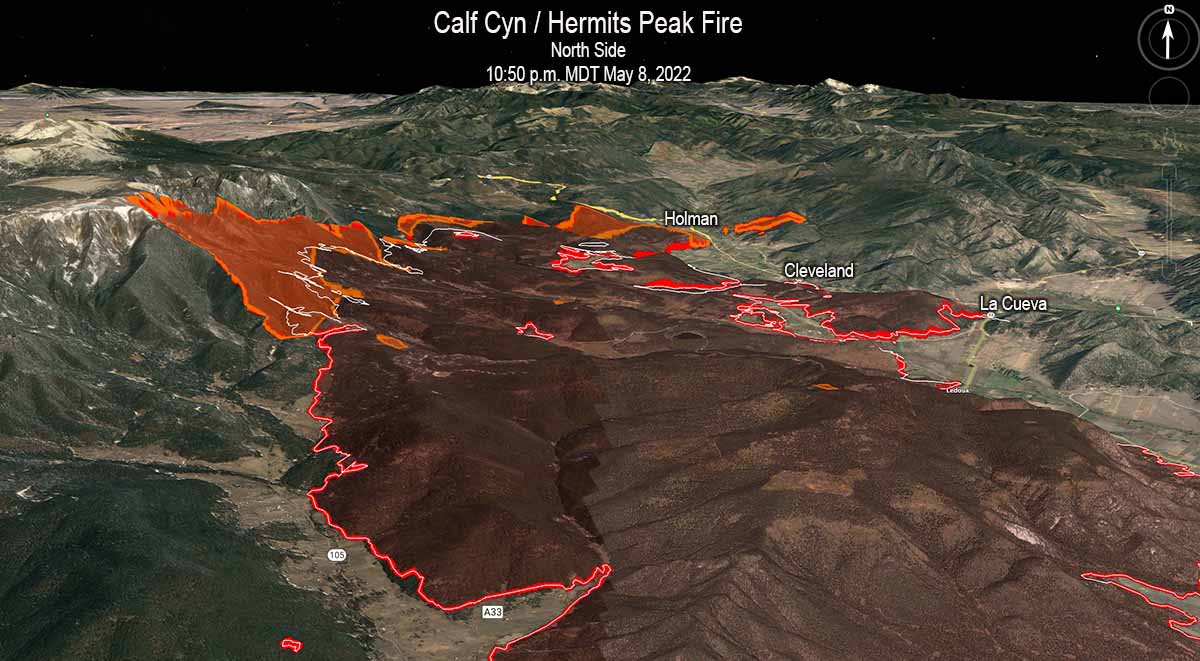
Updated to add the 3-D map of the north end of the Calf Canyon / Hermits Peak Fire.
To see all articles on Wildfire Today about the Calf Canyon / Hermits Peak Fire, including the most recent, click here.
Updated at 9:23 a.m. MDT May 9, 2022
Both of the large wildfires in Northern New Mexico were very active Sunday, pushed by the very strong winds.
Cerro Pelado Fire
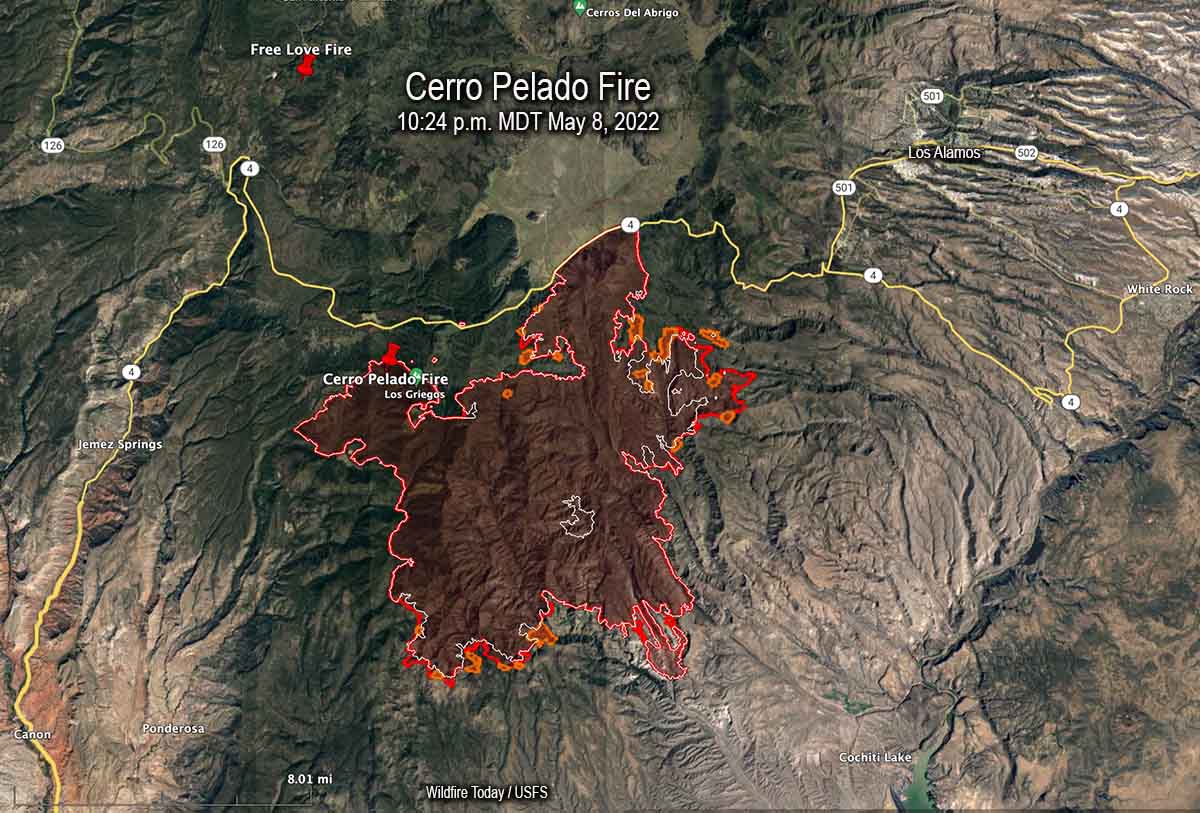
The most significant spread of the Cerro Pelado Fire Sunday was on the northeast side south of Highway 4 where it spread for about a mile east and crossed the FR 289 road. When the fire was mapped at 10:24 p.m. Sunday a large spot fire had come very close to crossing the next road to the east, FR 287. The fire grew by more than 3,000 acres Sunday to bring the size up to 40,958 acres.
Calf Canyon / Hermits Peak Fire
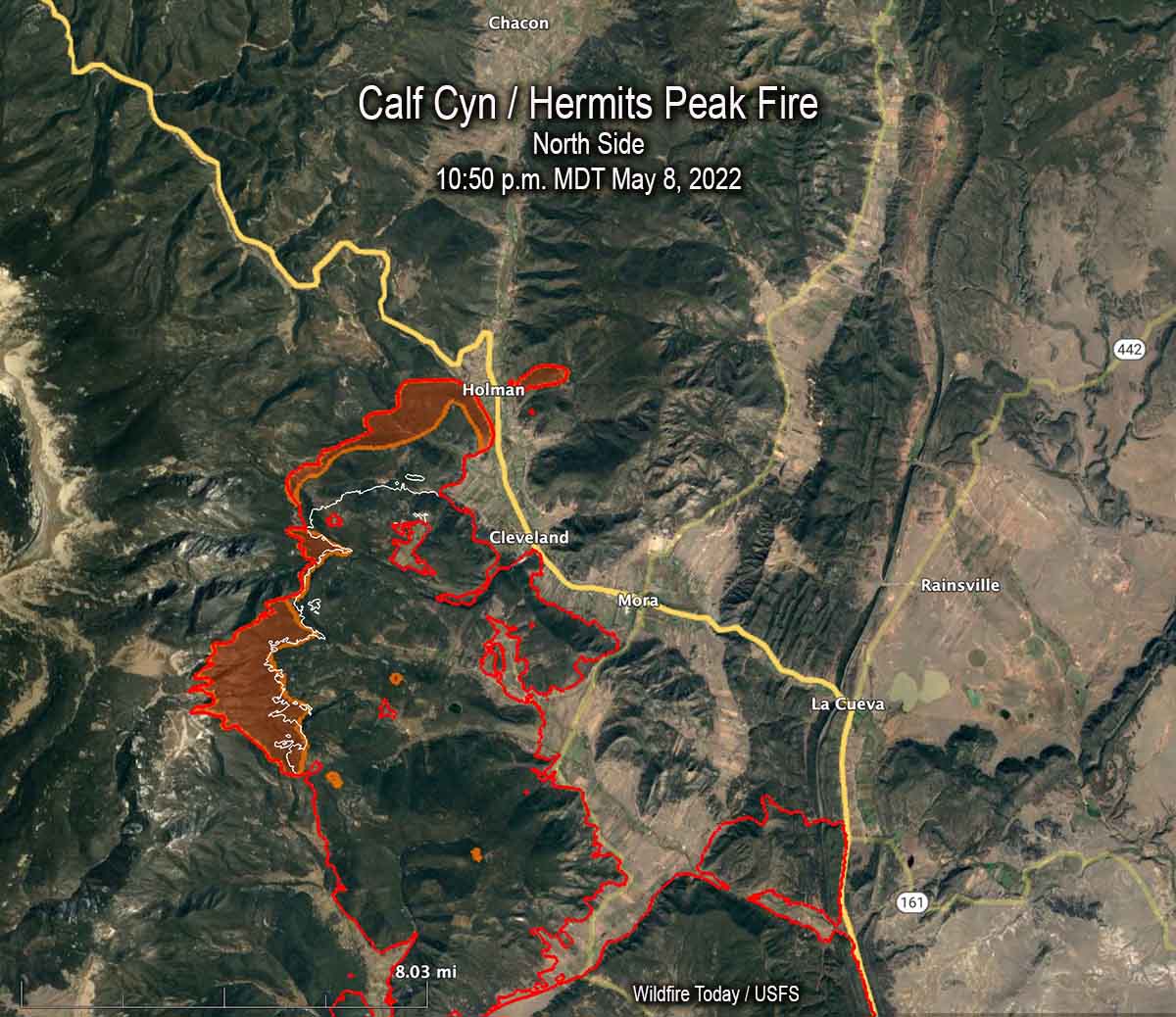
Most of the significant growth on the Calf Canyon / Hermits Peak Fire was on the north and south sides. When it was mapped at 10:50 p.m. on Sunday the north side, northwest of Cleveland, had advanced for about two miles further north coming close to Holman. There was a large 200-acre spot fire across Highway 518 east of Homan.
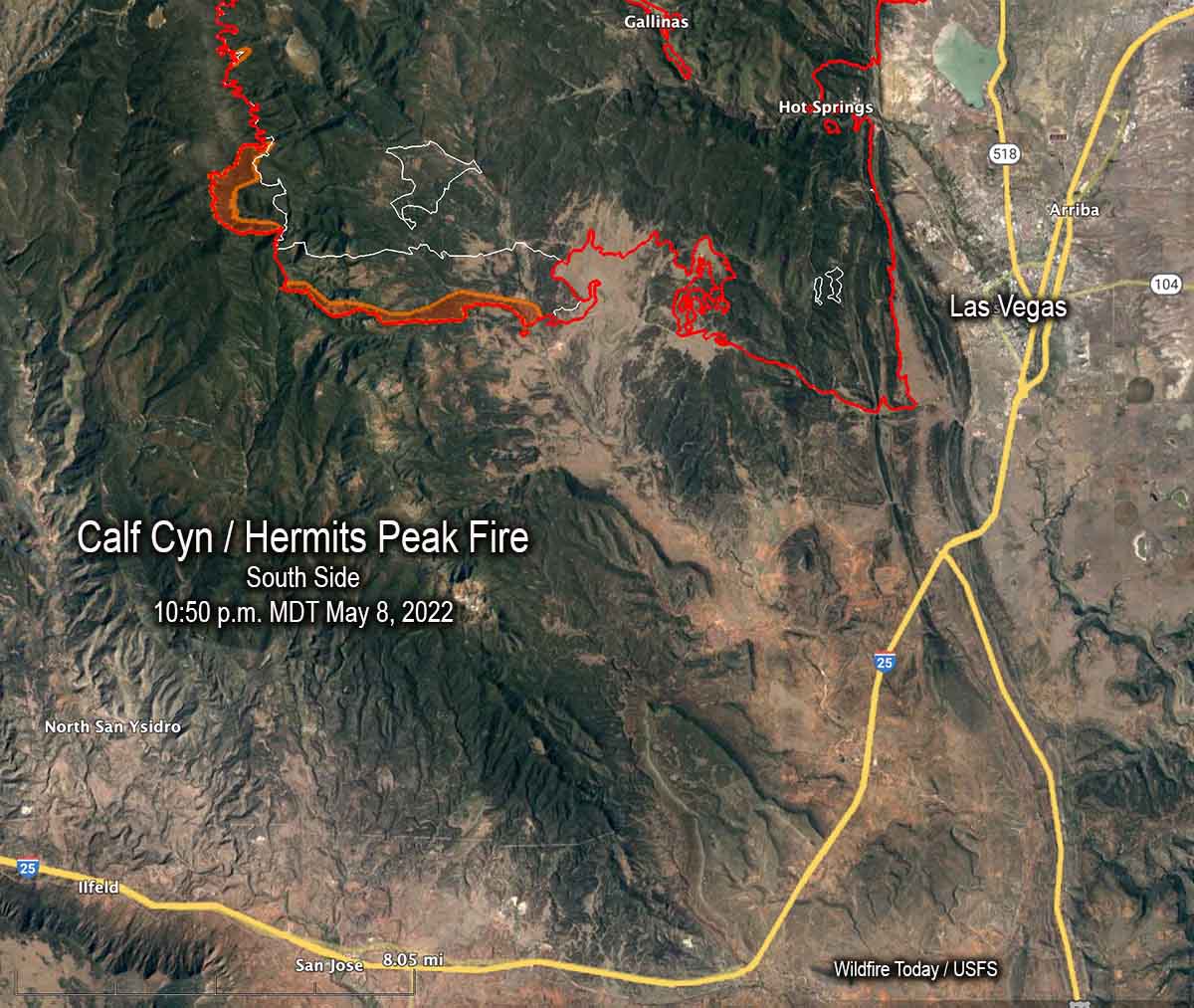
The east side of the Calf Canyon / Hermits Peak Fire still appears to be secure and the Sunday night map showed no change south of Mora and La Cueva near Highway 518. There was also no change near Las Vegas. But about 8 miles west of Las Vegas south of Highway 283 it spread south for an additional mile.
The fire grew by more than 13,000 acres Sunday to bring the size up to 189,767 acres.
Updated at 7:13 p.m. MDT May 8, 2022
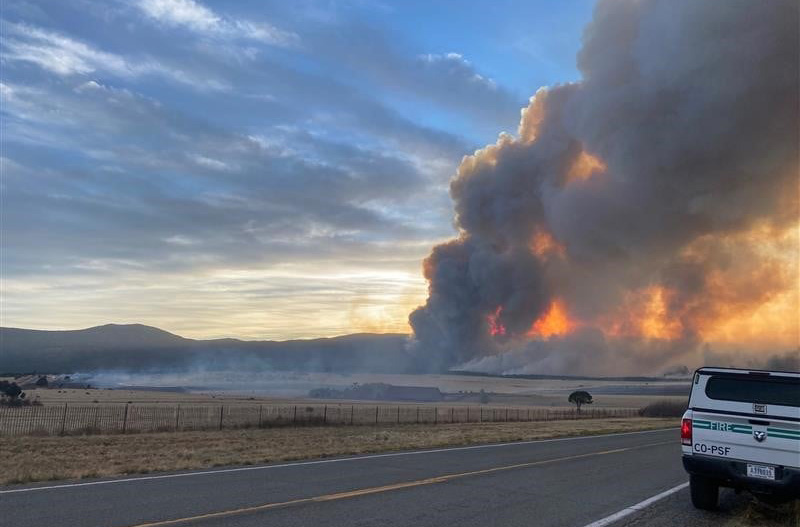
Calf Canyon / Hermits Peak Fire
The Calf Canyon / Hermits Peak Fire near Las Vegas, New Mexico made it through Saturday’s wind event without any major devastating runs beyond the existing firelines, but it is not over yet. Red Flag Warnings are again in place Sunday for strong winds, low humidity, and very dry vegetation. The forecast for Sunday and Monday is for sustained 32 mph winds gusting out of the west-southwest at 40 to 48 mph with 8 percent relative humidity.
Operations Section Chief Todd Abel said Saturday evening that one of the most active areas on the fire was on the southwest side near Highway 283. He also said all aircraft working on the fire had to be shut down around noon Saturday when the winds became too turbulent.
The fire has burned 176,000 acres.
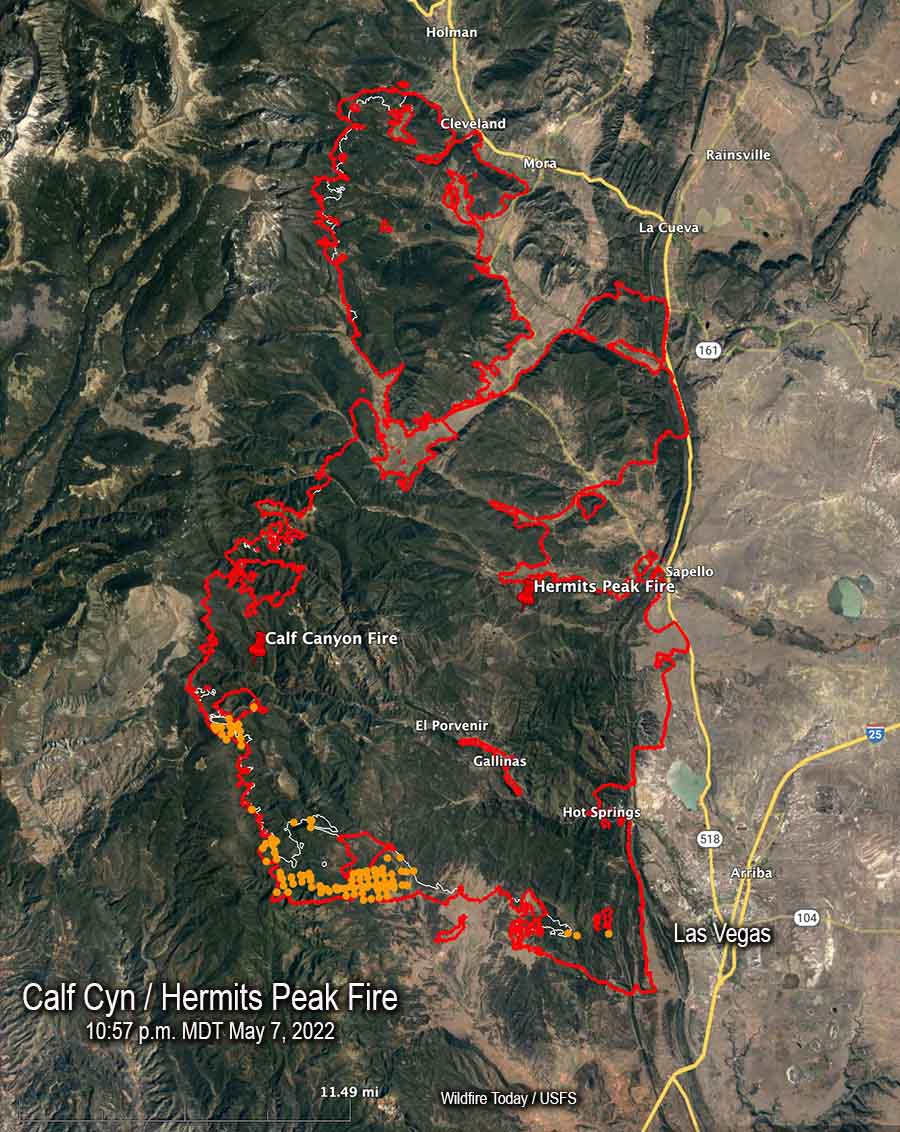
Cerro Pelado Fire
On Friday and Saturday most of the spread of the Cerro Pelado Fire was on the northeast side south of Highway 4, and on the southwest side. The 37,525-acre blaze is seven miles west-southwest of Los Alamos, New Mexico.
On the eastern side of the fire the FR 289 road is considered a primary line as the fire continued to advance in that direction pushed by 35 mph winds. A spot fire crossed the road late Saturday afternoon. Crews working that night shift described conditions in the area as “unbearable” due to wind, dust, smoke, and heat. Crews later engaged the spot fire at 3:00 a.m. Sunday when visibility had improved. Most of the movement to the east occurred in steep canyons. FR 289 has been prepped and plumbed with extensive hose lines.
Crews are coordinating with the National Park Service for structure protection in Bandelier National Monument and Valles Caldera National Preserve.
A Red Flag Warning is in effect for Sunday. The forecast for the fire area is for 39 mph winds gusting out of the west-southwest at up to 55 mph with relative humidity as low as 9 percent. On Monday the wind speeds will drop to 24 mph with gusts of 31 to 39 mph from the west-southwest.
Most of the blaze is in the footprint of the Las Conchas Fire that burned 156,593 acres in 2011. In a trial jurors found that two power companies were 95 percent responsible for starting that fire and the U.S. Forest Service was 5 percent responsible. The cause of the current Cerro Pelado Fire is listed as unknown.
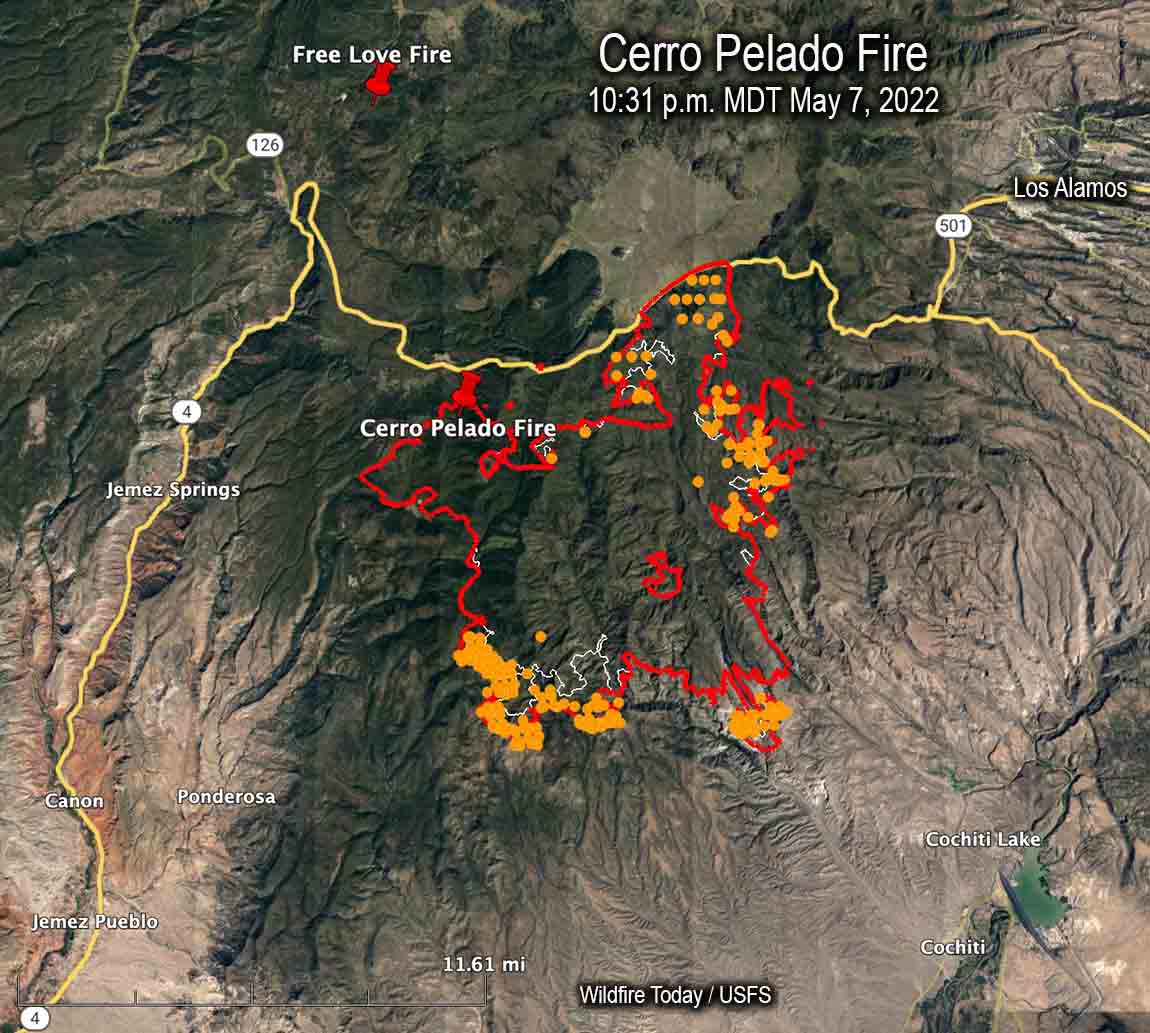
Winds gusting at more than 40 mph will test firelines on the east and northeast sides of the fire
Updated 5:32 p.m. MDT May 6, 2022
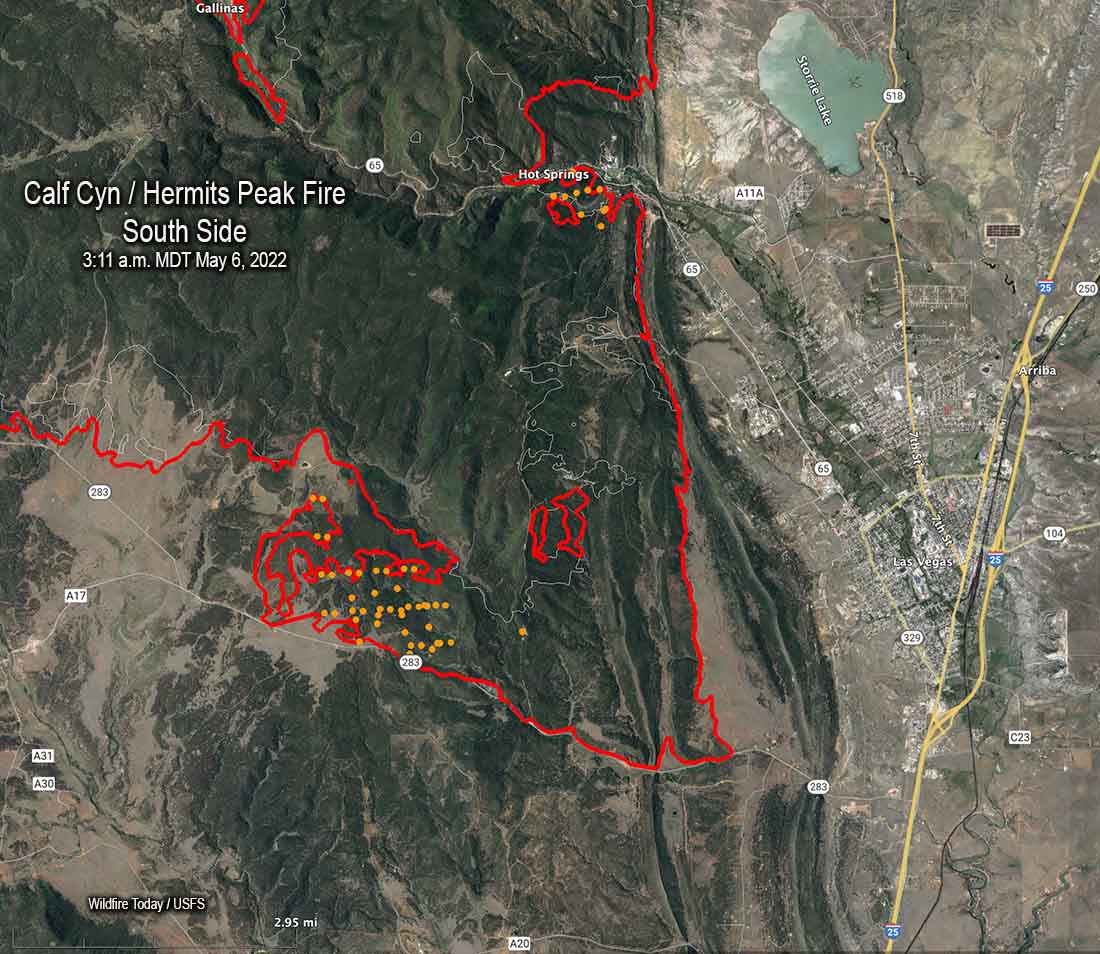
Most of the growth of the Calf Canyon / Hermits Peak Fire on Wednesday and Thursday was in three areas, on the north side west of Mora, on the southwest side near Bear Mountain, and the southeast side west of Las Vegas. Most of the additional acres near Las Vegas were a result of large burning operations conducted by firefighters to secure the fire edge. A mapping flight Thursday night determined that the fire had burned 168,009 acres, an increase of about 8,000 acres over the previous two days.
An area that is of concern to many residents in the area, the portion of the fire near Las Vegas, is “looking awesome”, said Operations Section Chief Todd Abel in a Friday morning briefing, implying there was not much active fire and the control lines are in place and holding.
Mr. Able said the weather and fire conditions have allowed firefighters to build direct fireline on the north side just west of the community of Cleveland, which is good news with strong winds in the forecast (see below for more weather information).
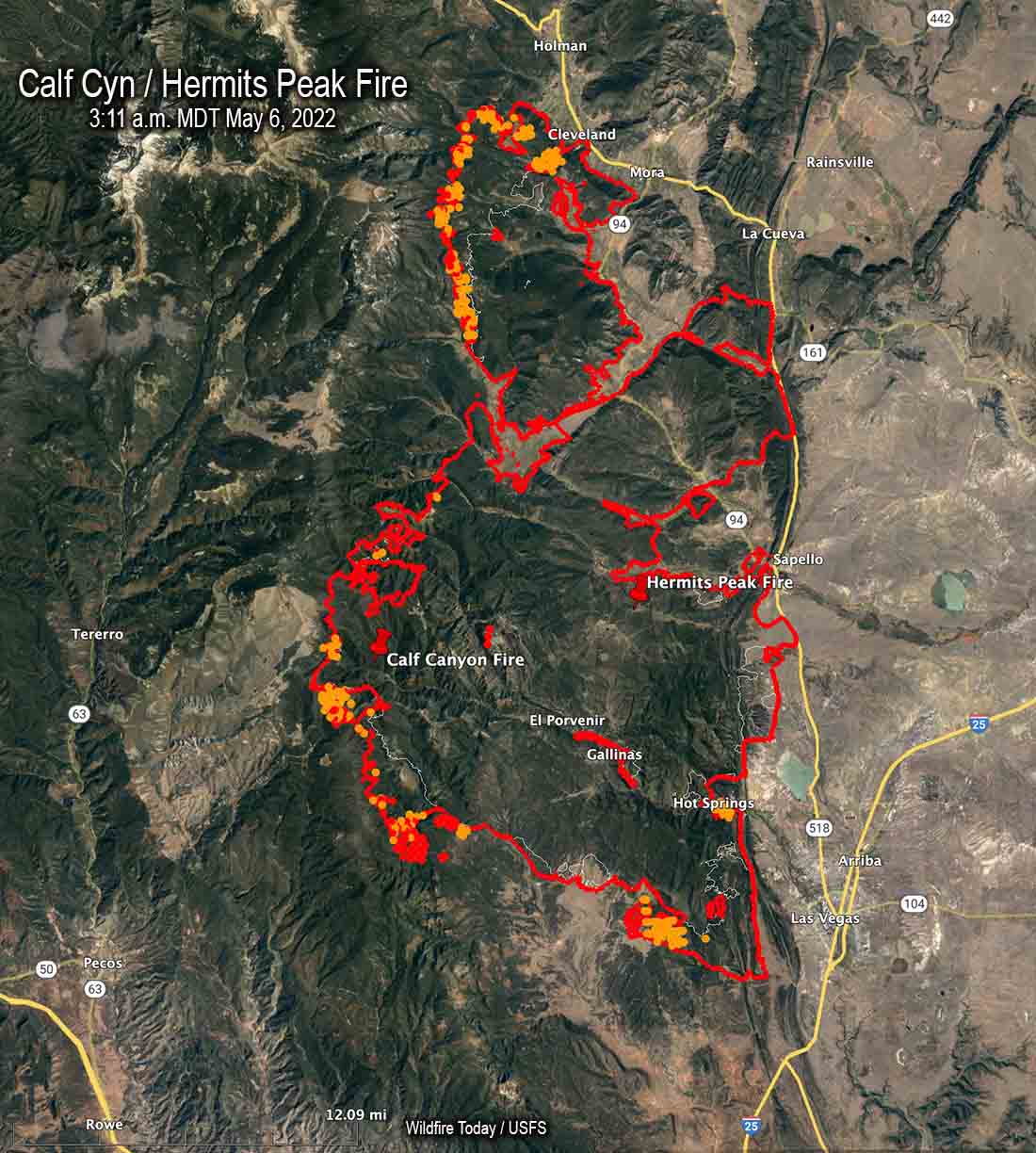
The weather is going to be a challenge again this weekend due to what firefighters call a “wind event”. According to the forecast Saturday will bring strong winds gusting to 39 mph, becoming even stronger on Sunday and Monday gusting to 45 mph. The direction will be generally out of the southwest and west while the minimum relative humidity each day hovers around 10 percent. These conditions will test the firelines on the east and northeast sides of the blaze. Firefighters, of course, are aware of the prediction and have been prepping structures, constructing and improving firelines, and building contingency lines further out.
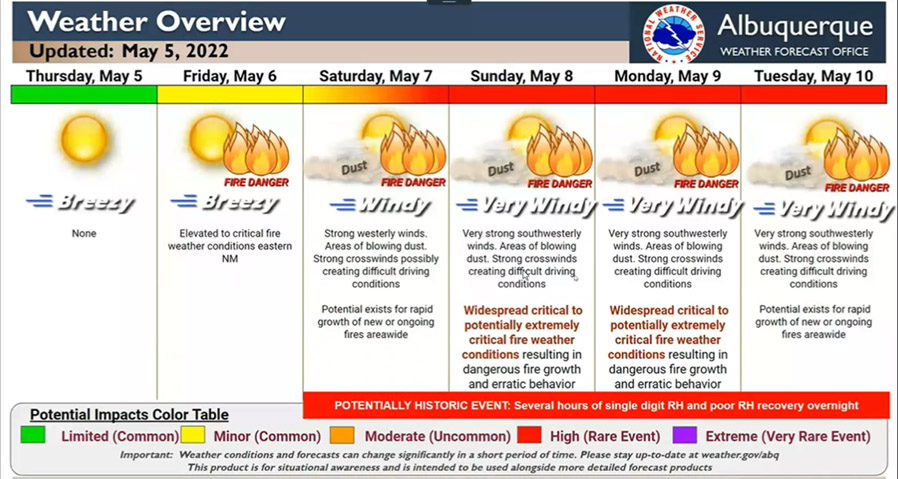
A multi-day critical fire weather event will impact mainly New Mexico through the next few days, and also much of SE Colorado, eastern Arizona and the Texas panhandle/west TX. A combination of strong winds, low humidity, & warm temperatures can contribute to extreme fire behavior pic.twitter.com/u2mhxpK5FU
— National Weather Service (@NWS) May 6, 2022
Over the last few days fire crews have been working north of the fire to be prepared if the fire makes a big run in that direction toward Chacon and Guadalupita South along the 519, 121, and 434 roads. Northeast and southeast of Mora they have used dozers to build firelines behind homes.
The Southwest Team #2 is bringing in a second team, a Type 2 team, Southwest Team #3. As explained by Operations Section Chief Todd Abel Friday morning, “They will integrate with our team. This means there’s still just one team, but we brought those people in to help us have a little bit more capacity so that if we have the potential to move further north that we have those folks available.”
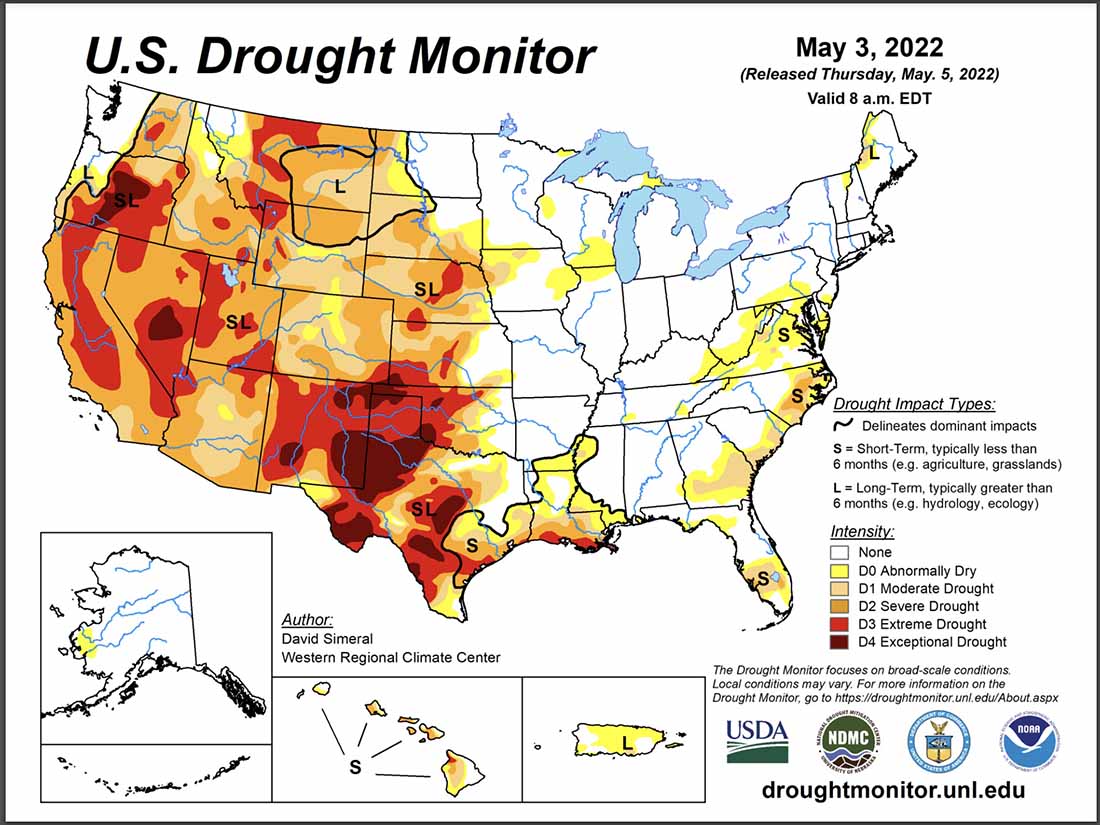
Most of New Mexico is in extreme or exceptional drought. The vegetation, or fuels, are atypically dry due to the drought, exacerbated by strong winds and high temperatures. Extremely dry fuels is one of the factors that can contribute to the rapid spread of a fire, especially when combined with very low humidity, high temperatures, and very strong winds.
The spread of the Calf Canyon / Hermits Peak Fire has been primarily through Ponderosa pine with a significant amount of dead and downed fuels in the understory. As the fire progresses downslope to the east, the dominant fuels transition through pinyon/juniper, Gambel oak, and brush to short grass.
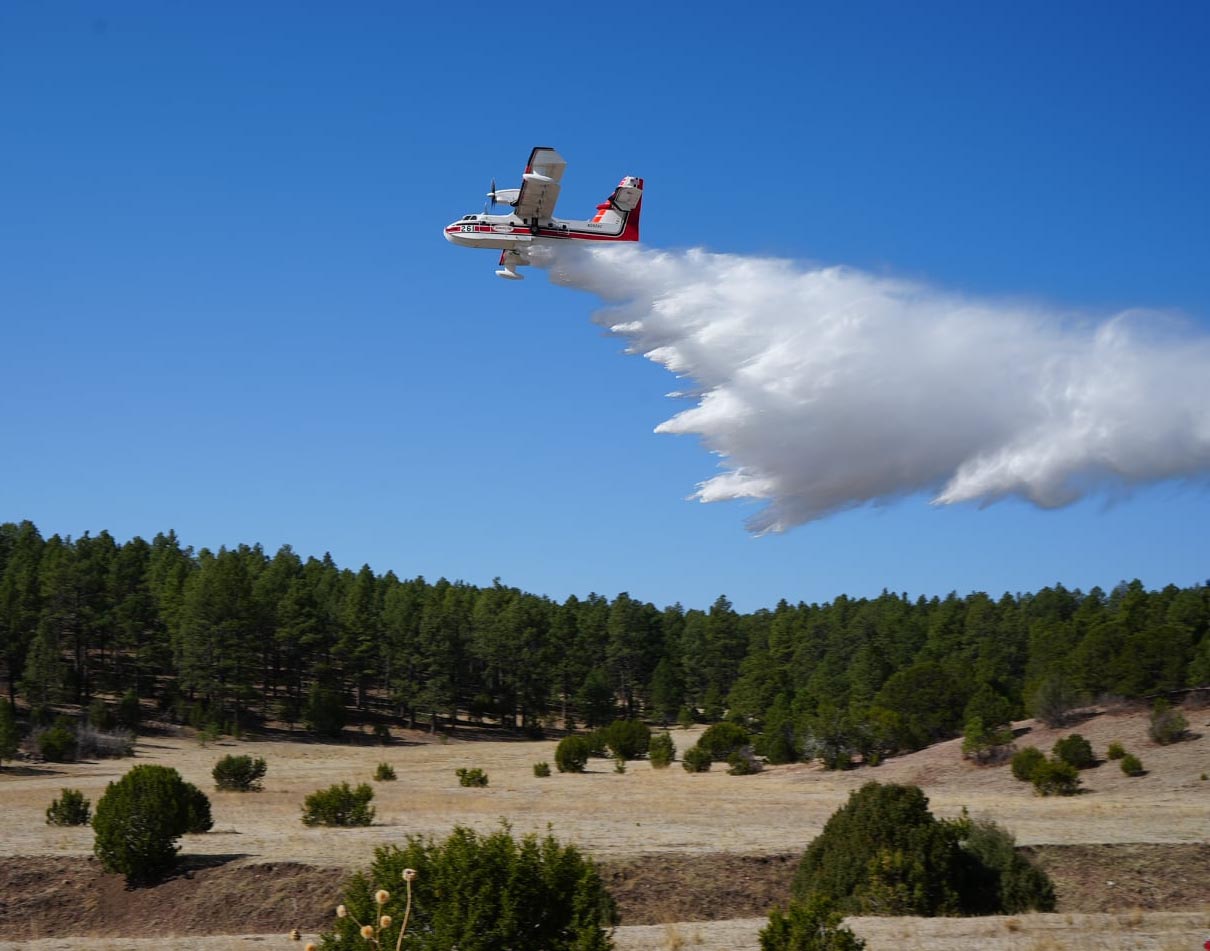

Air tankers and helicopters assisting firefighters Tuesday provided an opportunity to engage aggressively on the ground. Structure protection, line construction and firing operations continued Wednesday.
The fire has grown to 160,104 acres and has destroyed 170 residences and 117 other structures.
To see all articles on Wildfire Today about the Calf Canyon and Hermits Peak Fires, including the most recent, click HERE.
Six Structure Protection Groups across the fire have been focusing on removing fuels, constructing line, and deploying other protection measures around homes and communities.

Crews continue to conduct firing operations to remove fuel between containment lines and the uncontrolled fire edge to control portions of fire. One of the largest is on the south end of the fire west of Las Vegas. It began near the Bradner Reservoir and worked south past Luna Community College down to Highway 283, a distance of 5.3 miles.
Firefighters are removing fuel along the north side of Highway 283 in case the fire comes down that far. This will also facilitate using the highway to anchor a firing operation if needed to keep the fire north of the highway.

On the north side of the fire a dozer line was constructed south of Cleveland and Mora from which crews burned out to help protect the communities.
A zoomable evacuation map is available online.
The weather forecast for Thursday indicates that the wind speeds will be lower than they have been for several days, 17 mph out of the west-northwest with relative humidity in the low teens. Friday will be similar, with slightly stronger winds from the west. The strong winds will return Saturday through Tuesday, out of the west and southwest. The speeds will be in the high 20s gusting close to 40 mph with single digit humidity.
Aviation resources include large and very large air tankers, 14 helicopters, and six water-scooping air tankers. The scooper planes are obtaining water at Lake Isabel which is on private property.
Other resources on the fire include 104 engines and 23 hand crews for a total of 1,208 personnel.
In the video below a firefighter ignites a burning operation near Highway 283.
Prescribed burn north of 283 to create containment line west of Las Vegas. #calfcanyonfire pic.twitter.com/Z6V9DT7LmB
— Andrew Hay (@theblueroute) May 4, 2022
Below Air Tanker 910, a DC-10, makes a drop after the lead plane marks the spot with smoke. @Ten_Tanker said the video was by @rightturnsonly.
Tanker 912 serving the #CalfCanyonFire in #NewMexico.
? to our Lead Plane!Video by @rightturnsonly@GovMLG #10_tanker #ReadyToServe #WildfireSeason #aerialfirefighting #dc10 #tanker #aviationdaily #aviationlovers pic.twitter.com/iddq0wDQUX
— 10_Tanker Air Carrier (@Ten_Tanker) May 4, 2022
23 miles east of Santa Fe, New Mexico
Updated 10:32 a.m. MDT May 3, 2022
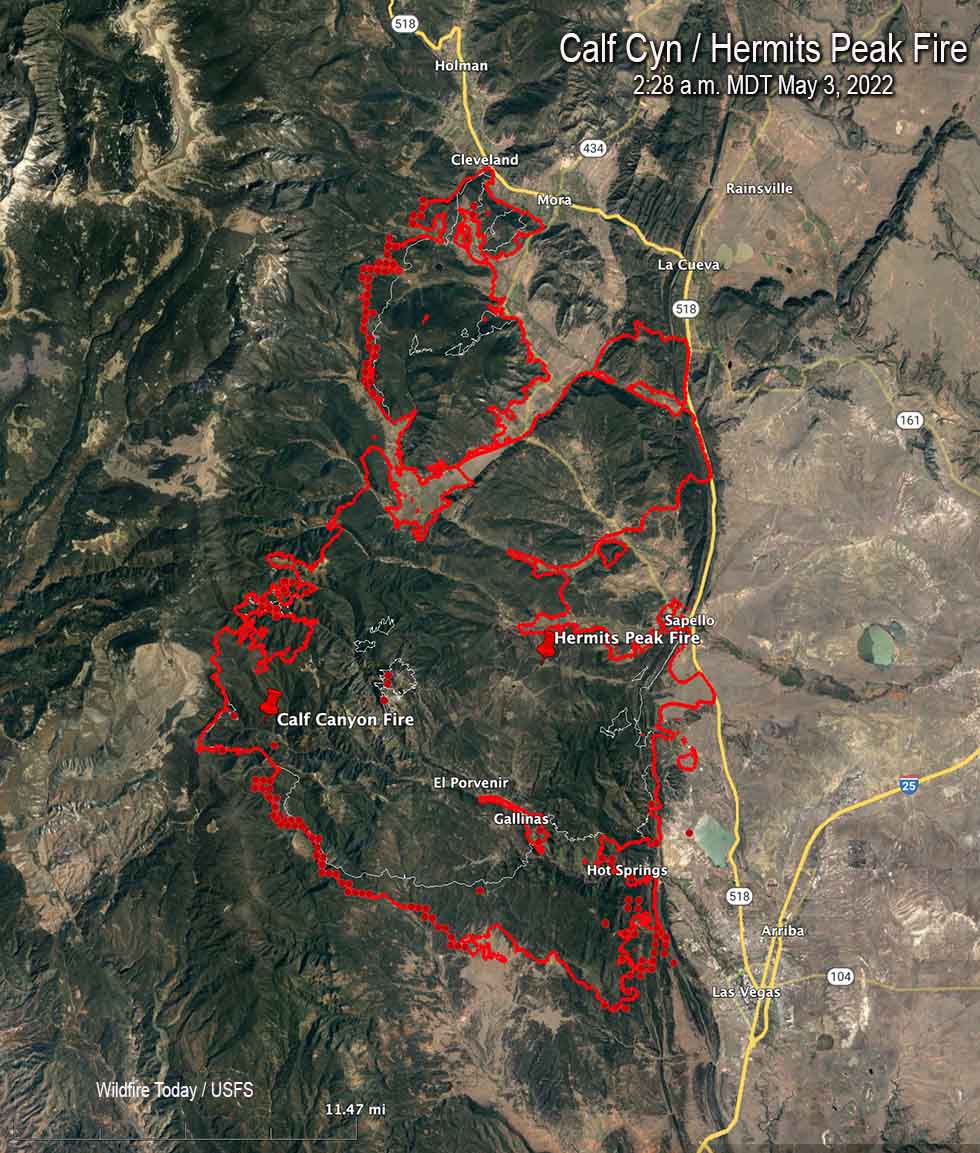
In spite of satellite photos showing massive amounts of smoke being generated by the Calf Canyon / Hermits Peak Fire, information released by the incident management team indicated that firefighters were able to make progress in several key areas of the fire on Monday. Large firing operations were conducted to widen fire lines and remove fuels ahead of a wind shift that could threaten communities.
The fire grew Monday to 145,854 acres, an increase of about 25,000 acres.
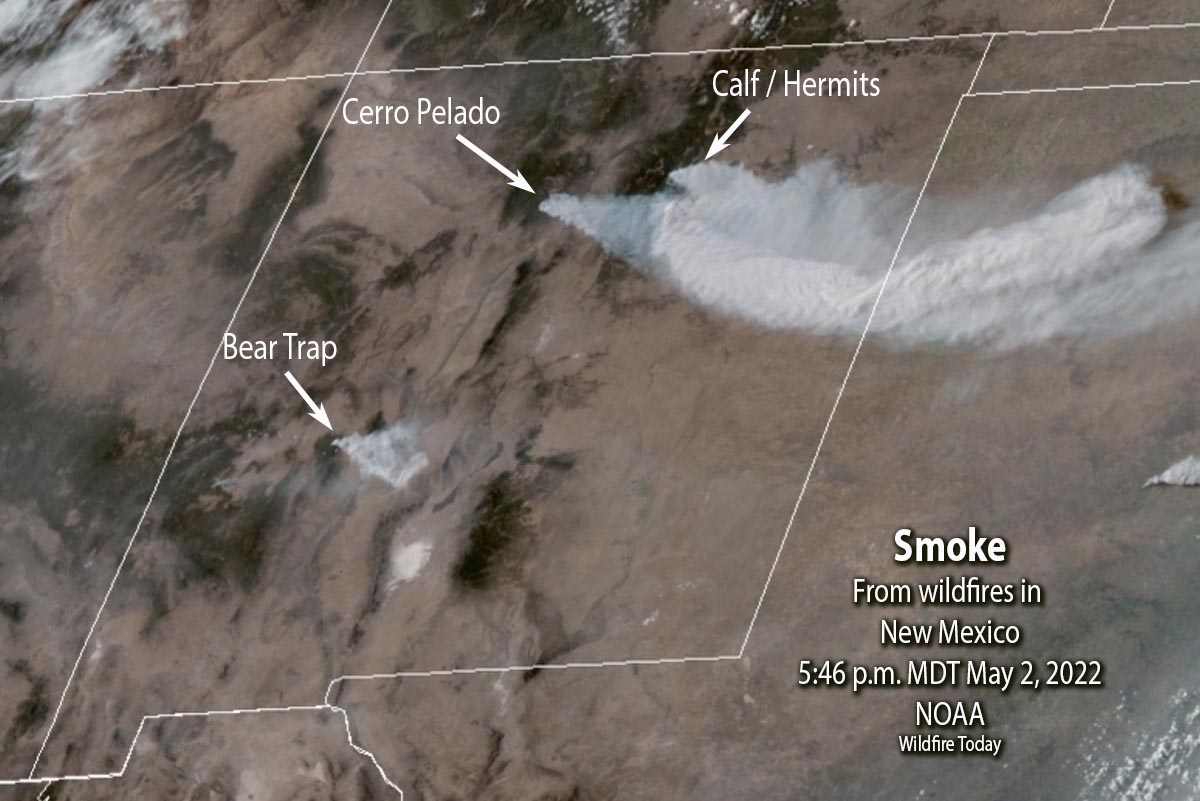
In addition to other aircraft, three DC-10 Very Large Air Tankers worked the fire Monday, dropping a total of nearly 28,000 gallons of retardant.
Structure protection crews have been removing fuels around buildings and securing lines around populated areas.
A Red Flag Warning is in effect Tuesday for nearly the entire state of New Mexico. The weather forecast is for 25 mph winds gusting out of the southwest at 37 mph with relative humidity of 12 percent. There is a slight chance of showers in the afternoon. On Wednesday the wind speeds will decrease to 20 mph from the west with the minimum humidity remaining at 12 percent.
A zoomable evacuation map is available online.
Below are maps of the north and south sides of the Calf Canyon / Hermits Peak Fire.
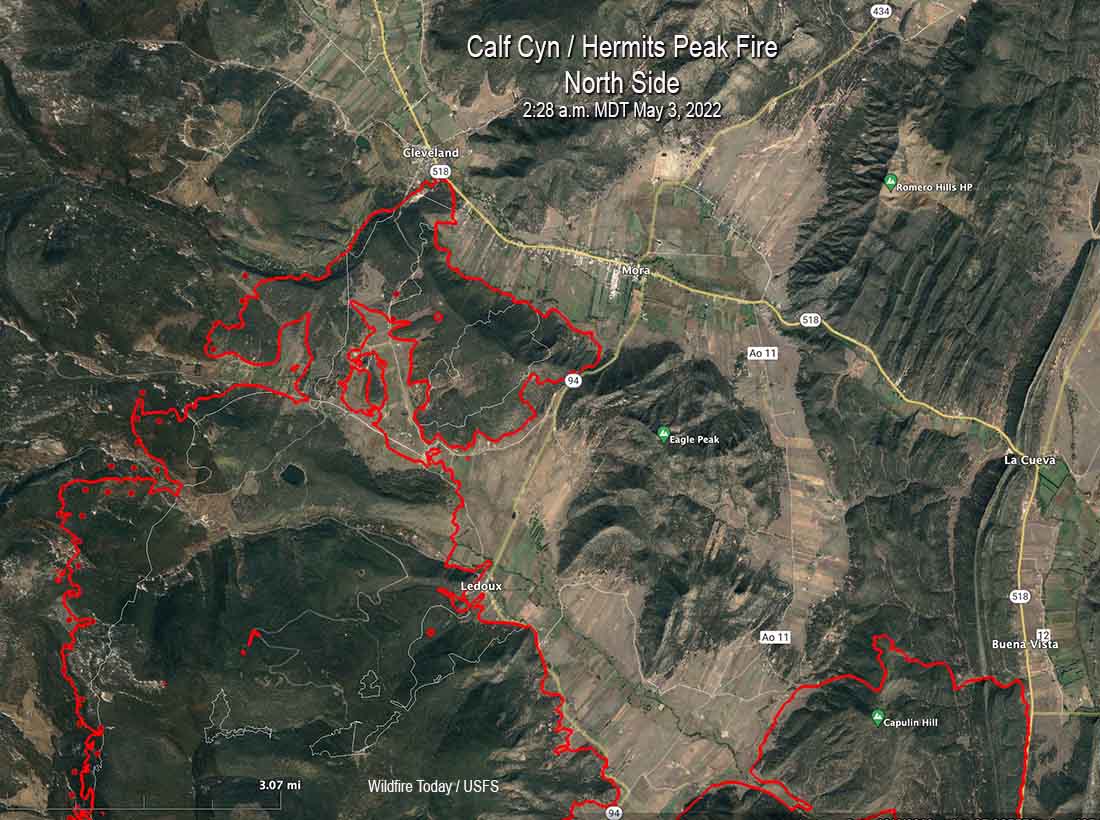
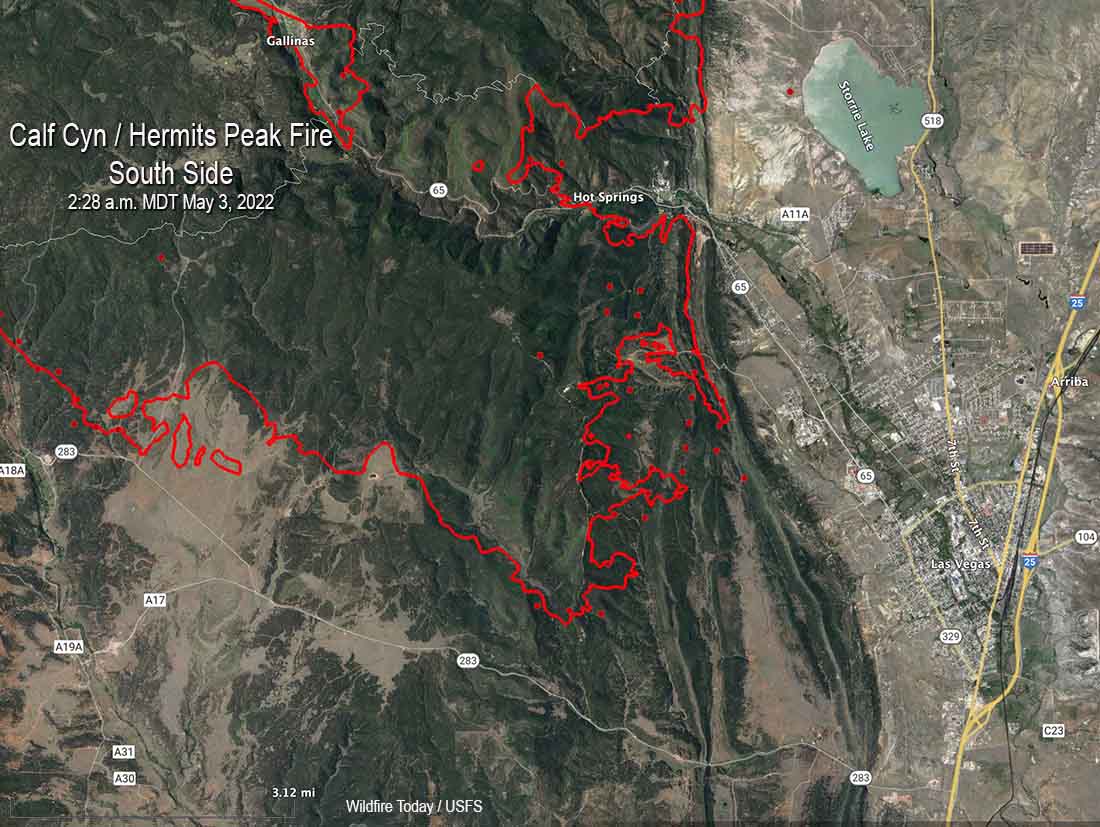
Resources assigned Monday evening included 20 hand crews, 14 helicopters, and 89 fire engines for a total of 1,085 personnel.
Continue reading “Calf Canyon / Hermits Peak Fire grows to more than 120,000 acres”
They have burned more than 60,000 acres
11:36 a.m. MDT April 26, 2022
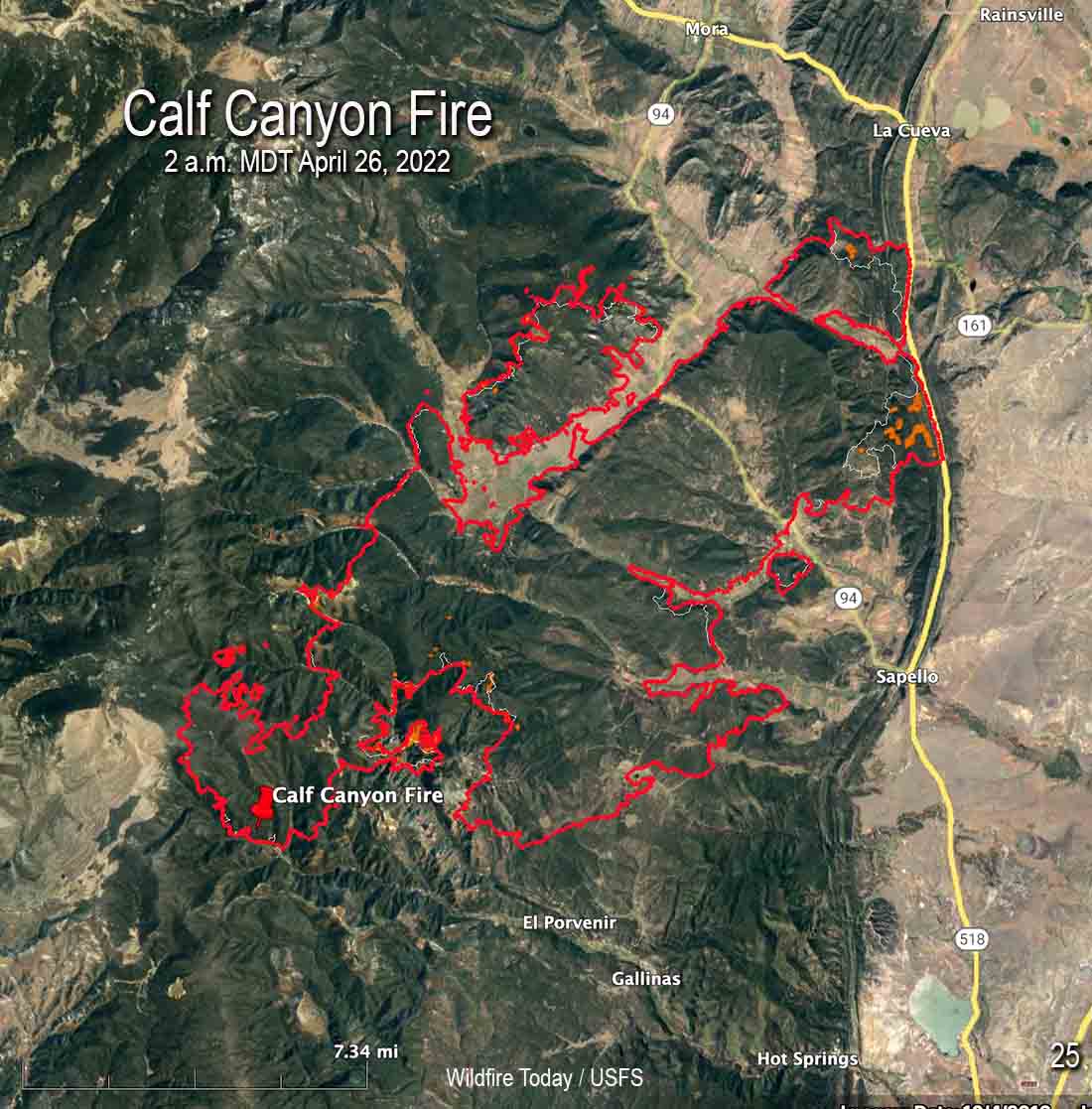
With more favorable weather conditions and less active fire behavior on the Calf Canyon and Hermits Peak Fires, on Monday firefighters were able to engage in operations in areas that had previously been difficult to reach safely.
There was incremental growth on Monday. The fire was mapped by an aircraft at 2 a.m. MDT Tuesday and found to have burned 60,173 acres. That is the combined size of the two fires that merged.
Firefighters were able to engage aggressively across the fire area yesterday, capitalizing on the favorable weather conditions.
To see all articles on Wildfire Today about the Calf Canyon and Hermits Peak Fires, including the most recent, click HERE.
“Fire managers are determining where to focus resources based on weather, terrain, predicted fire behavior, and values at risk,” according to a statement issued by the Incident Management Team.”These decisions are based on the highest probability of success and flexible options in the event of sudden changes in weather or fire behavior.”
Law enforcement agencies are assessing impacts the fire had on structures and will be notifying property owners once confirmed.
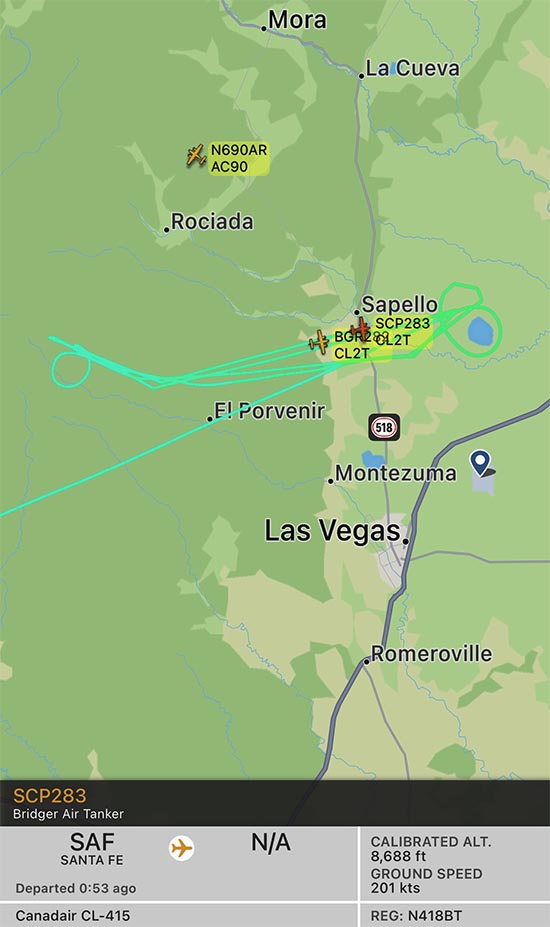
Beginning Monday and continuing on Tuesday, four water-scooping air tankers have been obtaining water from Lake Isabel and dropping it on the fire. To date, the scoopers along with other aircraft have delivered over 265,000 gallons. The lake is 8 miles east of the east side of the fire, which would be about a 5 minute one-way trip carrying up to 1,600 gallons of water. The map above shows the track of one of two CL-415 air tankers working the fire at 10:52 a.m. on Tuesday. An icon for a second CL-415 is also seen, but without its track — they often work in pairs.

The wind will be out of the southwest at 20 mph Tuesday increasing to 24 with gusts to 32 on Wednesday. The forecast calls for the relative humidity to be in the high teens Tuesday, and on Wednesday in the 20s with a chance of thunderstorms and a small amount of rain.